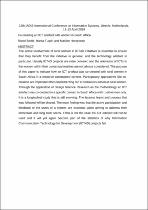JavaScript is disabled for your browser. Some features of this site may not work without it.
- ResearchSpace
- →
- Research Publications/Outputs
- →
- Conference Publications
- →
- View Item
| dc.contributor.author |
Smith, Ronel

|
|
| dc.contributor.author |
Herselman, Martha E

|
|
| dc.contributor.author |
Turpin, Marita

|
|
| dc.date.accessioned | 2019-09-25T06:56:00Z | |
| dc.date.available | 2019-09-25T06:56:00Z | |
| dc.date.issued | 2019-04 | |
| dc.identifier.citation | Smith, R., Turpin, M. and Herselman, M.E. 2019. Co-creating an ICT artefact with women in South Africa. 12th IADIS International conference on Information Systems, Utrecht, Netherlands, 11-13 April 2019 | en_US |
| dc.identifier.isbn | 978-989-8533-87-6 | |
| dc.identifier.uri | https://www.is-conf.org/wp-content/uploads/2019/04/Program_IS-20191.pdf | |
| dc.identifier.uri | http://www.iadisportal.org/digital-library/co-creating-an-ict-artefact-with-women-in-south-africa | |
| dc.identifier.uri | http://hdl.handle.net/10204/11125 | |
| dc.description | Copyright: 2019 IADIS Publications. Due to copyright restrictions, the attached PDF file only contains the abstract of the full text item. For access to the full text item, kindly consult the publisher's website. | en_US |
| dc.description.abstract | The active involvement of rural women in ICT4D initiatives is essential to ensure that they benefit from the initiative in general, and the technology artefact in particular. Usually ICT4D projects are male centered and the relevance of ICTs to the women within their contextual realities are not always considered. The purpose of this paper is indicate how an ICT artefact was co-created with rural women in South Africa in a resource constrained context. Participatory approaches like co-creation are important when implementing ICT4D initiatives aimed at rural women. Through the application of Design Science Research as the methodology an ICT artefact was co-created in a specific context in South Africa with rural women only. It is a longitudinal study that is still evolving. The lessons learnt and process that was followed will be shared. The main finding was that the active participation and feedback of the users of a system are essential when aiming to address their immediate and long term needs. If this is not the case the ICT artefact will not be used and it will yet again become part of the statistics of why Information Communication Technology for Development (ICT4D) projects fail. | en_US |
| dc.language.iso | en | en_US |
| dc.publisher | IADIS Publications | en_US |
| dc.relation.ispartofseries | Worklist;22452 | |
| dc.subject | Design science research methodology | en_US |
| dc.subject | Information Communication Technology for Development | en_US |
| dc.subject | ICT4D | en_US |
| dc.subject | ICT4D rural women initiatives | en_US |
| dc.subject | ICT artefacts | en_US |
| dc.title | Co-creating an ICT artefact with women in South Africa | en_US |
| dc.type | Conference Presentation | en_US |
| dc.identifier.apacitation | Smith, R., Herselman, M. E., & Turpin, M. (2019). Co-creating an ICT artefact with women in South Africa. IADIS Publications. http://hdl.handle.net/10204/11125 | en_ZA |
| dc.identifier.chicagocitation | Smith, Ronel, Martha E Herselman, and Marita Turpin. "Co-creating an ICT artefact with women in South Africa." (2019): http://hdl.handle.net/10204/11125 | en_ZA |
| dc.identifier.vancouvercitation | Smith R, Herselman ME, Turpin M, Co-creating an ICT artefact with women in South Africa; IADIS Publications; 2019. http://hdl.handle.net/10204/11125 . | en_ZA |
| dc.identifier.ris | TY - Conference Presentation AU - Smith, Ronel AU - Herselman, Martha E AU - Turpin, Marita AB - The active involvement of rural women in ICT4D initiatives is essential to ensure that they benefit from the initiative in general, and the technology artefact in particular. Usually ICT4D projects are male centered and the relevance of ICTs to the women within their contextual realities are not always considered. The purpose of this paper is indicate how an ICT artefact was co-created with rural women in South Africa in a resource constrained context. Participatory approaches like co-creation are important when implementing ICT4D initiatives aimed at rural women. Through the application of Design Science Research as the methodology an ICT artefact was co-created in a specific context in South Africa with rural women only. It is a longitudinal study that is still evolving. The lessons learnt and process that was followed will be shared. The main finding was that the active participation and feedback of the users of a system are essential when aiming to address their immediate and long term needs. If this is not the case the ICT artefact will not be used and it will yet again become part of the statistics of why Information Communication Technology for Development (ICT4D) projects fail. DA - 2019-04 DB - ResearchSpace DP - CSIR KW - Design science research methodology KW - Information Communication Technology for Development KW - ICT4D KW - ICT4D rural women initiatives KW - ICT artefacts LK - https://researchspace.csir.co.za PY - 2019 SM - 978-989-8533-87-6 T1 - Co-creating an ICT artefact with women in South Africa TI - Co-creating an ICT artefact with women in South Africa UR - http://hdl.handle.net/10204/11125 ER - | en_ZA |






